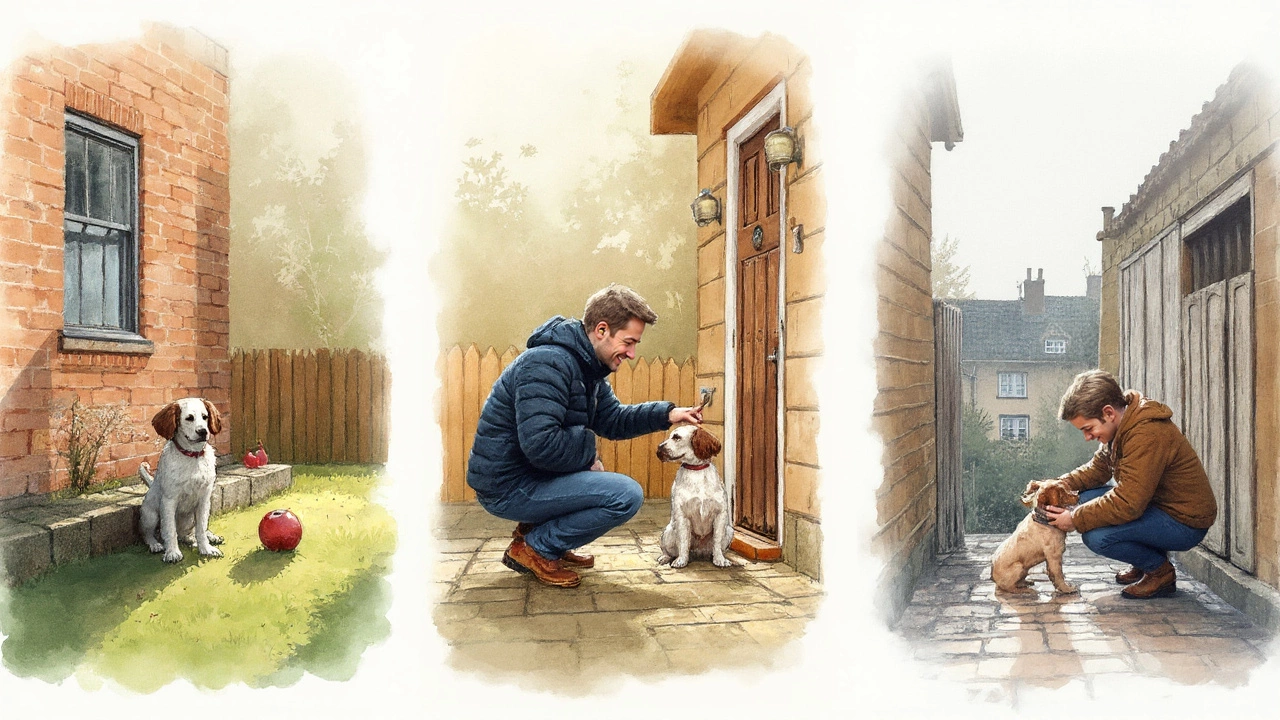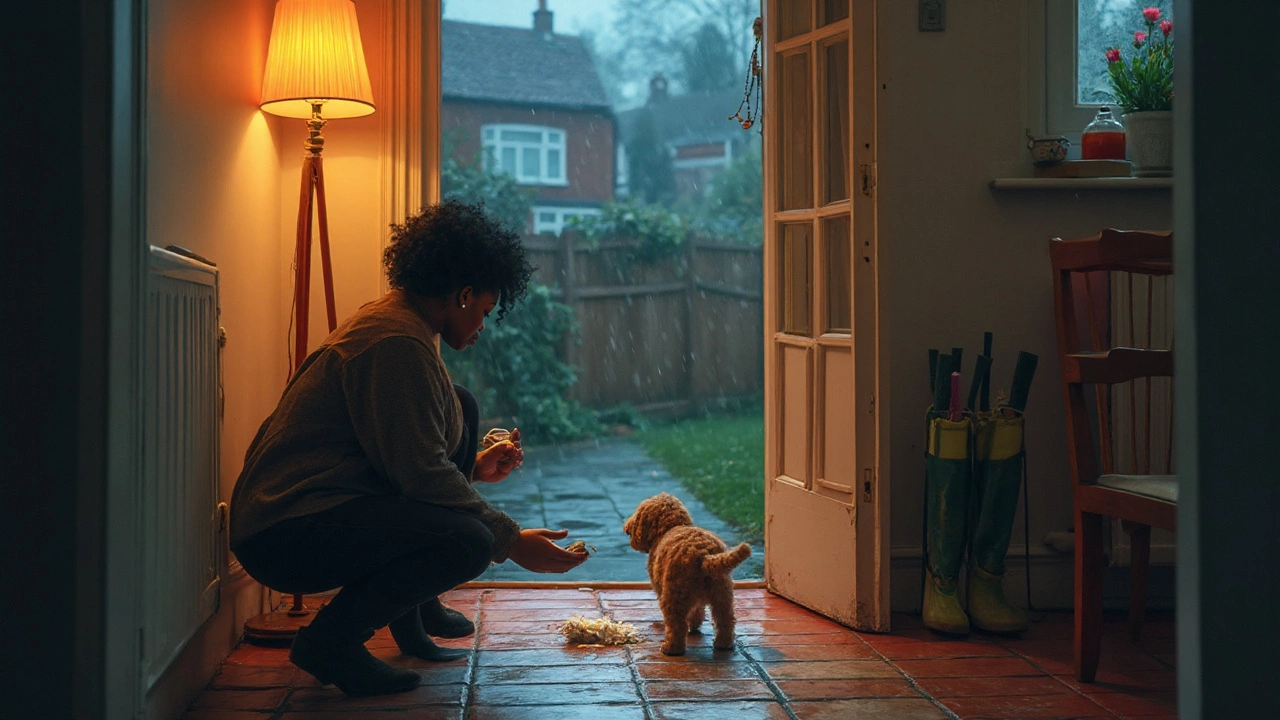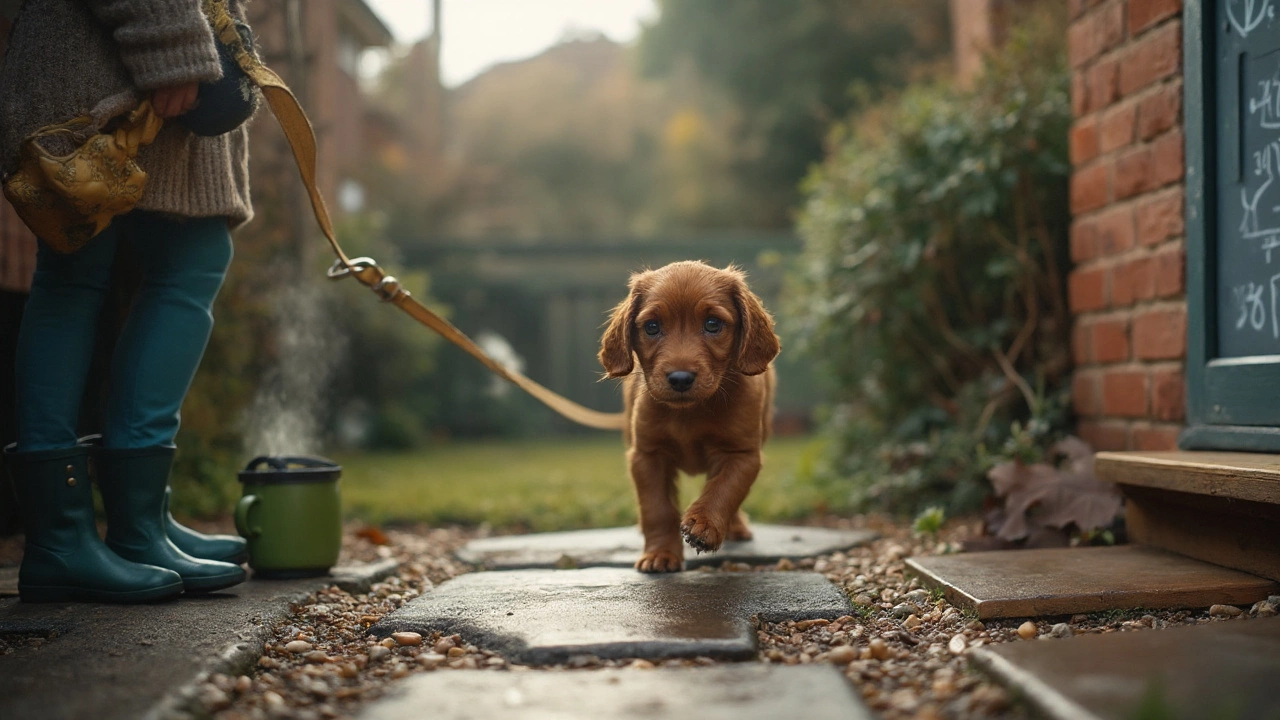Here’s the hard truth: most puppies aren’t reliably house‑trained in a weekend. You’re looking at daily practice for weeks, with real reliability often arriving around the 3‑month mark. Some breeze through faster; some take longer. How long does it take to potty train a puppy? Short answer: expect 2-3 months of consistent work, with occasional accidents for a bit longer.
- Typical timeline: habit building in 2-4 weeks; solid daytime reliability around 8-12 weeks of practice. Nights improve later.
- Rule of thumb: bladder capacity ≈ months of age + 1 hour (up to 5-6 hours max). Young pups can’t “hold it.”
- Wins come from timing: outside right after sleep, play, and meals; reward within 2 seconds; clean misses with enzyme spray.
- Setbacks are normal during growth spurts, teething, routine changes, or bad weather. Adjust and reset the routine.
- Small breeds often take longer because tiny bladders empty fast. It’s not stubbornness; it’s anatomy.
What “potty trained” actually means (and a realistic timeline)
When people say “potty trained,” they usually mean two things: the puppy chooses the right spot on their own and can wait for reasonable intervals between toilet breaks. That second piece-waiting-depends on age and development more than obedience.
Here’s a grounded way to think about it:
- Weeks 8-10: You’re teaching patterns, not control. Expect a toilet trip after every nap, play burst, and meal. Daytime breaks every 1-2 hours.
- Weeks 10-12: Slightly better bladder control; most still need hourly checks and immediate trips after triggers (sleep, play, food).
- Weeks 12-16: Many pups start to “ask out” and can hold 2-3 hours in the day. Night stretch grows to 4-6 hours for some.
- Months 4-6: Daytime reliability improves. You still supervise, but accidents drop-often to rare oops moments.
- Months 6-12: Full reliability. Some small or sensitive breeds don’t hit “zero accidents” until this window.
Common benchmarks (not promises):
- Fast learners: almost accident‑free days in 3-4 weeks; nights stabilise by 12-16 weeks old.
- Average pups: 8-12 weeks of training to feel confident during the day, with occasional nighttime wake‑ups until 5-6 months.
- Small breeds/toy types: often need more frequent breaks and longer to generalise (new rooms, new surfaces). Think 3-6 months for “very reliable.”
Why the spread? Bladder size, metabolism, activity level, surface preferences, and your routine. There’s also biology: the “months of age + 1 hour” rule holds only to a point (max 5-6 hours for healthy juveniles). The AVMA points out that puppies lack sphincter control early on, and the RSPCA stresses that reward‑based methods speed learning and reduce stress. The AKC’s common guideline on interval limits mirrors the months+1 rule. None of these bodies recommend punishment for accidents-it slows progress.
The step‑by‑step game plan (daily routine that actually works)
Set up the environment so the right choice is easy and the wrong one is hard. You’ll use three tools: a schedule, a small safe space (crate/pen), and instant rewards.
- Pick one toilet surface. Grass, real sod on a balcony, or a covered patch if you live somewhere wet. I’m in Wellington, and wind plus sideways rain taught me fast: cover the potty spot. My husband, Callum, and I split the first week of dawn trips-worth it.
- Control access indoors. Use a crate that lets your puppy stand up, turn, and lie down-no bigger. Add a playpen or tether to you with a 2-3 metre lead. Freedom expands as accidents drop.
- Run a tight schedule for 2-3 weeks.
- First thing on waking (no talking, straight out).
- After every nap.
- After every play burst.
- 10-15 minutes after meals and big drinks.
- Before bedtime and any time you crate for more than 30-60 minutes.
- Stand still. Reward fast. Go to the spot, say nothing while they sniff. The moment they finish, mark with “Yes!” and hand 2-3 tiny treats. Praise like they solved climate change.
- Add a cue. Say your cue word (“toilet” or “be quick”) as they start. In a week or two, you can say it at the spot and they’ll know what to do.
- Feed on schedule. Two to three meals at the same times daily. Predictable input = predictable output. Pick up water 1-2 hours before bed.
- Night plan. Young pups need one middle‑of‑the‑night trip. Quiet, lights low, back to bed immediately.
- Handle accidents correctly.
- Interrupt gently if you catch them (a soft “Ah‑ah”), scoop them up, and finish outside. Reward if they go.
- Missed it? Clean with an enzymatic cleaner. No scolding. Ammonia cleaners smell like pee to dogs and attract repeats.
- Crate basics. 30-60 minutes of calm time between active breaks for very young pups. Give a safe chew and a stuffed food toy so the crate predicts something good.
- Bell or button training (optional). Hang a bell at the door. Nose‑touch the bell, open door, go potty, treat. Repeat. Soon your puppy rings for toilet breaks instead of pacing.
Markers you’re on track: accidents drop weekly, your puppy starts heading to the door, and they empty quickly outside instead of sniffing forever. If you feel stuck, reduce freedom indoors, shorten intervals, and boost rewards.

Examples, schedules, and a quick‑reference table
Two real‑life schedules to copy and tweak. Use timers. You won’t need this forever-just the first few weeks.
Example A: 10‑week puppy, work‑from‑home
- 6:30 am: Outside immediately, reward.
- 6:45 am: Breakfast. Outside at 7:00 am.
- Play 10 minutes → crate with chew until 8:00 am.
- 8:00 am: Outside, reward. Short play. Supervised freedom 20 minutes.
- 9:00 am: Outside. Nap in crate 60-90 minutes.
- 10:30 am: Outside. Play/training. Water break.
- 12:00 pm: Lunch. Outside 12:15 pm.
- 1:30 pm: Outside. Quiet time.
- 3:00 pm: Outside. Play.
- 5:30 pm: Dinner. Outside 5:45 pm.
- 7:00 pm: Outside. Calm evening.
- 9:00 pm: Final big toilet trip. Lights out by 9:30-10:00 pm. One night break around 1-2 am.
Example B: 16‑week puppy, 9-5 job (with midday help)
- 6:00 am: Outside. Breakfast 6:15 am. Outside 6:30 am.
- 7:30 am: Outside. Enrichment toy in crate.
- 12:00-1:00 pm: Midday drop‑in walk/toilet.
- 5:15 pm: Outside immediately after you get home.
- 7:00 pm: Dinner. Outside 7:15 pm.
- 9:30 pm: Last trip. Many 4‑month‑olds can sleep through now.
Apartment or rainy climate? Put a real‑grass patch or a covered potty station near the door. Start there, then shift outdoors when reliable. If weather is wild, toss a raincoat on your pup and keep the cue word-it helps them go quickly.
| Puppy Age | Daytime Interval (hrs) | Night Stretch (hrs) | Trips per Day | Accident Risk |
|---|---|---|---|---|
| 8-10 weeks | 1-2 | 2-4 | 12-16+ | High without supervision |
| 10-12 weeks | 1.5-2.5 | 3-5 | 10-14 | Moderate-High |
| 12-16 weeks | 2-3 | 4-6 | 8-12 | Moderate |
| 4-6 months | 3-4 | 6-8 | 6-10 | Low-Moderate |
| 6-12 months | 4-6 | 8 | 4-8 | Low |
Note: Toy and small breeds often sit at the lower end of these ranges. Giants can stretch slightly longer but still need early, frequent practice to learn the routine.
Checklists, cues, and progress markers
Starter kit checklist
- Right‑sized crate (standing room, turn, lie down).
- Playpen or baby gates to block carpeted zones.
- 6‑foot lead and a lightweight house line (for shadowing your pup indoors).
- High‑value treats (pea‑sized), kept by the door.
- Enzymatic cleaner for accidents; paper towels.
- Portable rain cover/umbrella or a covered potty area.
- Real grass patch or litter tray (if in a high‑rise).
- Timer app or smartwatch reminders.
Quick cues that predict success
- “Yes!” or a click the instant they finish peeing/pooping.
- One simple toilet cue word (“toilet” / “be quick”).
- Calm walk to the spot, no chatter until after they go.
- Two or three treats, not a handful-you’ll repeat this many times.
Progress markers (what to expect by week)
- Week 1: You’re doing most of the work. Puppy empties quickly outside after sleep/play/food.
- Week 2: Fewer random accidents. Puppy starts moving to the door or pausing at you before going.
- Week 3: You can lengthen some intervals by 15-30 minutes. Night wakes reduce.
- Week 4+: One or fewer accidents per week indoors, often due to missed breaks or big excitement.
Common triggers and what to do
- Excitement pee (common in friendly, young pups): Keep greetings low‑key. Greet outside first. Reward calm.
- Substrate preference (carpet is “nice”): Block carpeted rooms for now; reward on grass every time to teach the right surface.
- Weather refusal: Use a covered spot; go out on lead; add your cue; reward immediately for even a small pee.
- New place, new rules: On trips, bring a bit of used potty pad or a cloth with your yard’s scent. Same cue, same rewards.
Fast diagnosis cheat sheet
- Accidents just started? Ask: Did I change the schedule? More water? New diet? Big life change (move, visitors)? Reset the routine for 3-5 days.
- Accidents happen right after coming inside? Stay out 3 minutes longer, walk less, stand still more, reward bigger.
- Peeing tiny amounts often, straining, blood, or licking genitals? Call your vet. UTIs and bladder irritation are medical, not training problems.
- Only inside on carpet? Block access. Add a tether indoors for 3-7 days to catch the “sniff, circle, squat” moment.

Mini‑FAQ and troubleshooting (plus next steps)
How long until my puppy sleeps through the night?
Many manage 6-8 hours by 14-16 weeks. Tiny breeds may need a 2 am break a bit longer. Keep nights boring: outside, quiet praise, back to bed.
Is crate training required?
Not required, but very helpful. Dogs avoid soiling their sleep space, which helps build the habit. Keep the crate positive with chews and stuffed food toys.
What about puppy pads?
They can be a bridge for apartments or severe weather. If you want pure outdoor training, skip pads to prevent mixed messages. If you do use pads, slowly move the pad closer to the door, then outside.
Should I punish accidents?
No. Scolding creates sneaky peeing and stress. The RSPCA and AVSAB recommend reward‑based methods only. Clean, supervise, and adjust timing.
My puppy “knows” but still has accidents. Why?
Dogs learn in contexts. “I go on grass outside” doesn’t automatically mean “not on the living room rug.” You must supervise and reward in every room until the rule sticks everywhere.
How often should a young puppy go out?
As a starting point: every hour at 8-10 weeks, every 1.5-2 hours at 10-12 weeks, every 2-3 hours by 12-16 weeks, plus after sleep, play, and meals.
What if I work full‑time?
Line up a midday visit for the first 8-12 weeks, or take them to a reputable daycare with outdoor breaks. Set up a pen with a bed area and a grass patch if no help is available, then transition to pure outdoor once they’re older.
We had a setback after moving house. Normal?
Yes. New smells, new layout. Go back to Week‑1 rules for 5-7 days: short intervals, heavy rewards, doors blocked, and supervised freedom.
My puppy pees when excited or scared.
That’s often excitement or submissive urination. Keep greetings calm, crouch sideways, no looming over the pup, and greet outdoors first. It improves with confidence and age.
Can diet affect potty training?
Yes. Many small, frequent meals can mean frequent stools. Feed at set times, choose a high‑quality puppy diet, and avoid sudden switches. Diarrhea or very soft stools warrant a vet chat.
When to see the vet?
Straining, blood, frequent dribbles, sudden increase in accidents without routine change, lethargy, or excessive thirst-get a check. House training can’t fix medical issues.
Next steps for different situations
- Busy 9-5 owners: Schedule a dog‑walker or neighbour at lunch for 3-6 weeks. Shorten mornings but make them predictable: out, eat, out. Evenings add a calm walk, then a last “be quick.”
- Apartment living: Start with a real‑grass tray by the balcony door. Once reliable, move it onto the balcony, then phase it out while increasing outdoor trips.
- Small breeds: Plan more frequent breaks (every 45-90 minutes early on). Use soft‑jaw treats and warm coats in cold wind so weather doesn’t become a reason to hold it.
- Rainy/windy areas: Covered potty station, non‑slip mat, and a clear cue word. Go on lead, stand still, and reward fast so your pup learns to go despite the weather.
- Multi‑dog homes: Let the older dog model, but still take the puppy alone to the spot for focused rewards. Manage doors so the puppy isn’t trailing and forgetting to go.
You’ll know you’re done when your puppy can hold a reasonable interval for their age, walks to the door to ask out, empties quickly on cue, and can handle new places without confusion. If you’re consistent with timing and rewards, most puppies hit that sweet spot in 8-12 weeks of practice. Keep your enzyme spray handy, stay patient, and celebrate the small wins-they stack up fast.
